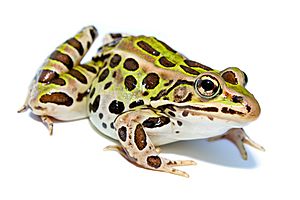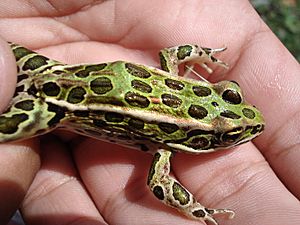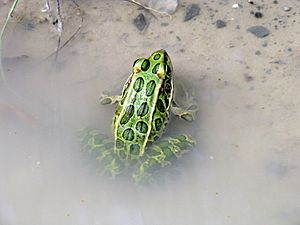Northern leopard frog facts for kids
Quick facts for kids Northern leopard frog |
|
|---|---|
 |
|
| Conservation status | |
| Scientific classification | |
| Genus: |
Lithobates
|
| Species: |
pipiens
|
The northern leopard frog (Lithobates pipiens or Rana pipiens) is a type of leopard frog. It belongs to the true frog family. These frogs live in parts of Canada and the United States. The northern leopard frog is the official state amphibian of Minnesota and Vermont.
Contents
- What Does a Northern Leopard Frog Look Like?
- Cool Color Variations
- Where Northern Leopard Frogs Live and What They Do
- Life Cycle and Reproduction
- Challenges for Northern Leopard Frogs
- What Northern Leopard Frogs Eat and Who Eats Them
- How Northern Leopard Frogs Help Science
- Northern Leopard Frogs as Pets
- Where Northern Leopard Frogs Live
- See also
What Does a Northern Leopard Frog Look Like?
Northern leopard frogs are quite large. They can grow to about 11 centimeters (4.3 inches) long. Their back, called the dorsal side, can be green or brown. They have big, dark, round spots on their back, sides, and legs. Each spot usually has a lighter ring around it.
Two raised lines, called dorsolateral folds, run down their back from behind their eyes. These lines are often lighter or sometimes pink. A pale stripe also goes from their nose, under their eye, and past their eardrum (tympanum) to their shoulder. Their belly, or ventral side, is white or light green. They have golden eyes and webbed toes.
Young northern leopard frogs, called Tadpoles, are dark brown or gray. They have light spots on their underside. Their tail is a pale tan color.
Cool Color Variations
Northern leopard frogs come in different colors. The most common ones are green and brown. There's also a special color type called the "burnsi morph." Frogs with the burnsi morph don't have spots on their backs. However, they might still have spots on their legs. They can be bright green or brown and have yellow lines on their backs. Very rarely, these frogs can also be albino, meaning they lack color.
Where Northern Leopard Frogs Live and What They Do
Northern leopard frogs live in many different places. You can find them in ponds, swamps, marshes, and slow-moving streams. They live in forests, open fields, and even city areas. They prefer water with lots of plants. In summer, they often leave the water and move into grassy areas or lawns.
These frogs can handle cold weather well. They can live in high places, even above 3,000 meters (9,800 feet) in the mountains. Male frogs make a short, snoring sound from the water during spring and summer.
Life Cycle and Reproduction
Northern leopard frogs breed in the spring, from March to June. A female frog can lay up to 6,500 eggs in the water. The tadpoles grow in the same pond where they hatched. Tadpoles are light brown with black spots. It takes them about 70 to 110 days to grow into small frogs, depending on the conditions. These young frogs are about 2 to 3 centimeters (0.8 to 1.2 inches) long and look like tiny adults.
Challenges for Northern Leopard Frogs
Northern leopard frogs used to be very common in parts of Canada and the United States. But their numbers started to drop in the 1970s. We don't know the exact reason for this decline. However, scientists think it's due to things like losing their homes (habitat loss). Other reasons include pollution, new types of fish, dry weather, and diseases. Many groups of northern leopard frogs have not yet recovered.
What Northern Leopard Frogs Eat and Who Eats Them
Many animals hunt northern leopard frogs. These include snakes, raccoons, other frogs, and even humans. Northern leopard frogs don't have bad-tasting skin. So, they rely on their speed to get away from danger.
These frogs eat many different small animals. Their diet includes crickets, flies, worms, and even smaller frogs. They have large mouths and can even swallow birds and garter snakes. Once, a bat was found as prey of this frog!
The northern leopard frog looks similar to the pickerel frog and the southern leopard frog.
How Northern Leopard Frogs Help Science
Medical Research
Northern leopard frogs produce special substances in their eggs called ribonucleases. Scientists are studying these substances as possible medicines for cancer. One of these, called ranpirnase, is being tested to treat certain types of lung tumors. Another one, amphinase, might help treat brain tumors.
Understanding the Nervous System
Since the 1950s, northern leopard frogs have been important for learning about how nerve cells work. Scientists have used their nerve and muscle connections to understand how our nervous system sends messages.
Studying Muscles and Movement
Northern leopard frogs are also popular for studying how muscles work. Scientists can easily get their leg muscles, and these muscles stay alive for hours outside the frog. This helps researchers understand how the frog's muscles help it jump and swim.
Northern Leopard Frogs as Pets
Northern leopard frogs can be good pets for beginners. A 20-gallon tank is big enough for one frog. You can add a piece of wood that goes from the water to the land. This helps the frog move around and gives it a place to rest.
The bottom of the tank should have a mix of peat and moss, covered with orchid bark and sphagnum moss. This should be at least 2-3 inches deep so the frog can burrow. The water side can have smooth gravel. It's important to use only smooth gravel to protect the frog's skin.
Northern leopard frogs like temperatures between 68 and 75 degrees Fahrenheit (20-24 degrees Celsius). A slight temperature drop at night, down to about 60 degrees Fahrenheit (16 degrees Celsius), is good for them. Make sure the tank has a secure lid, preferably a mesh one for air. Frogs are very good at escaping!
You can feed northern leopard frogs crickets, mealworms, waxworms, or silkworms.
Where Northern Leopard Frogs Live
Northern leopard frogs live from Great Slave Lake and Hudson Bay in Canada. Their range goes south to Kentucky and New Mexico in the USA. They are also found in Panama. However, the frogs in Panama might be a different, unnamed species. They like to live in grasslands, by lakes, and in marshes.
See also
 In Spanish: Rana leopardo para niños
In Spanish: Rana leopardo para niños






